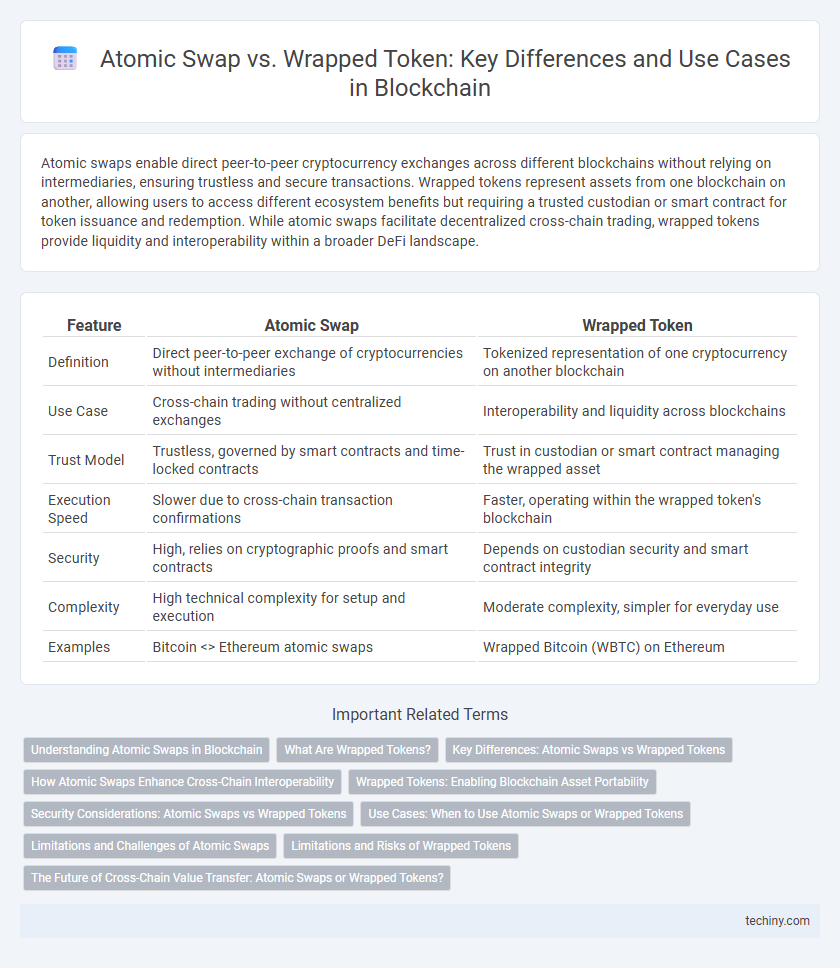Atomic swaps enable direct peer-to-peer cryptocurrency exchanges across different blockchains without relying on intermediaries, ensuring trustless and secure transactions. Wrapped tokens represent assets from one blockchain on another, allowing users to access different ecosystem benefits but requiring a trusted custodian or smart contract for token issuance and redemption. While atomic swaps facilitate decentralized cross-chain trading, wrapped tokens provide liquidity and interoperability within a broader DeFi landscape.
Table of Comparison
| Feature | Atomic Swap | Wrapped Token |
|---|---|---|
| Definition | Direct peer-to-peer exchange of cryptocurrencies without intermediaries | Tokenized representation of one cryptocurrency on another blockchain |
| Use Case | Cross-chain trading without centralized exchanges | Interoperability and liquidity across blockchains |
| Trust Model | Trustless, governed by smart contracts and time-locked contracts | Trust in custodian or smart contract managing the wrapped asset |
| Execution Speed | Slower due to cross-chain transaction confirmations | Faster, operating within the wrapped token's blockchain |
| Security | High, relies on cryptographic proofs and smart contracts | Depends on custodian security and smart contract integrity |
| Complexity | High technical complexity for setup and execution | Moderate complexity, simpler for everyday use |
| Examples | Bitcoin <> Ethereum atomic swaps | Wrapped Bitcoin (WBTC) on Ethereum |
Understanding Atomic Swaps in Blockchain
Atomic swaps enable direct peer-to-peer cryptocurrency exchanges across different blockchains without intermediaries, enhancing security and reducing counterparty risk. These smart contract-based transactions ensure that either both parties successfully exchange assets or no transfer occurs, preventing partial losses. Wrapped tokens, in contrast, represent assets from one blockchain on another, relying on trusted custodians, whereas atomic swaps maintain decentralization by eliminating the need for third parties.
What Are Wrapped Tokens?
Wrapped tokens are blockchain-based assets that represent cryptocurrencies from different blockchains, enabling seamless interoperability and liquidity across decentralized platforms. They are tokenized versions of native assets, such as Wrapped Bitcoin (WBTC) on Ethereum, allowing users to utilize Bitcoin's value within Ethereum's DeFi ecosystem. By locking the original asset in a smart contract and issuing an equivalent wrapped token, wrapped tokens facilitate cross-chain operations without relying on centralized exchanges.
Key Differences: Atomic Swaps vs Wrapped Tokens
Atomic swaps enable direct peer-to-peer cryptocurrency exchanges across different blockchains without intermediaries, utilizing smart contracts for trustless, decentralized trading. Wrapped tokens represent assets from one blockchain on another by locking the original asset and minting a corresponding token, facilitating cross-chain liquidity and compatibility with DeFi protocols. Key differences include atomic swaps' emphasis on trustless, on-chain asset exchanges versus wrapped tokens' reliance on custodial or smart contract mechanisms to bridge assets across blockchains.
How Atomic Swaps Enhance Cross-Chain Interoperability
Atomic swaps enable direct peer-to-peer exchanges of cryptocurrencies across different blockchains without intermediaries, significantly reducing reliance on centralized exchanges. By facilitating trustless, on-chain transactions, atomic swaps enhance cross-chain interoperability and security in decentralized finance ecosystems. This protocol supports seamless asset exchanges, improving liquidity and expanding the functionality of multi-blockchain applications.
Wrapped Tokens: Enabling Blockchain Asset Portability
Wrapped tokens facilitate blockchain asset portability by representing cryptocurrencies from one blockchain on another, enabling seamless cross-chain transactions without relying on centralized exchanges. Unlike atomic swaps that execute direct peer-to-peer asset exchanges through smart contracts, wrapped tokens maintain liquidity and interoperability by leveraging collateralized token issuance. This mechanism supports decentralized finance (DeFi) applications by expanding the usability of native assets across multiple blockchain networks.
Security Considerations: Atomic Swaps vs Wrapped Tokens
Atomic swaps enhance security by enabling direct peer-to-peer cryptocurrency exchanges without relying on intermediaries, reducing counterparty risk and exposure to hacks. Wrapped tokens increase liquidity and cross-chain compatibility but introduce custodial risk since they depend on third-party smart contracts or custodians to lock and issue the underlying assets. Security vulnerabilities in wrapped token protocols, such as smart contract bugs or centralized control, can result in asset loss, making atomic swaps a more trustless alternative for secure cross-chain transactions.
Use Cases: When to Use Atomic Swaps or Wrapped Tokens
Atomic swaps excel in enabling direct peer-to-peer cryptocurrency exchanges across different blockchains without intermediaries, ideal for decentralized trading and cross-chain interoperability. Wrapped tokens are best suited for integrating assets from one blockchain onto another, allowing users to leverage tokens within decentralized finance (DeFi) platforms, liquidity pools, and smart contracts on foreign chains. Choose atomic swaps for secure, trustless exchanges and wrapped tokens for cross-chain asset utilization and enhanced liquidity.
Limitations and Challenges of Atomic Swaps
Atomic swaps face limitations such as limited interoperability between different blockchain protocols, often requiring complex scripting and time-locked contracts that can increase transaction failure risks. The scalability of atomic swaps is constrained by network congestion and variable confirmation times, reducing their efficiency compared to wrapped tokens, which offer easier cross-chain asset transfers through tokenization. Furthermore, atomic swaps demand significant technical expertise and user coordination, presenting usability challenges that hinder widespread adoption.
Limitations and Risks of Wrapped Tokens
Wrapped tokens face risks such as reliance on centralized custodians, which introduces counterparty risk and potential vulnerabilities to hacks or fraud. They may suffer from liquidity fragmentation and interoperability issues due to varying standards across blockchain networks. The limitation of trust assumptions undermines the core decentralized ethos of blockchain, making atomic swaps a more secure alternative for trustless token exchanges.
The Future of Cross-Chain Value Transfer: Atomic Swaps or Wrapped Tokens?
Atomic swaps enable trustless, direct peer-to-peer exchanges of cryptocurrencies across different blockchains, eliminating intermediaries and reducing counterparty risk. Wrapped tokens represent assets from one blockchain on another through tokenization, facilitating liquidity and interoperability but relying on custodial or smart contract mechanisms. The future of cross-chain value transfer hinges on advancements in atomic swap protocols enhancing scalability and user experience, alongside improved security models for wrapped tokens to maintain decentralization and trust.
Atomic swap vs Wrapped token Infographic

 techiny.com
techiny.com